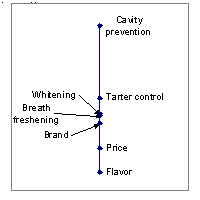 |
Maximum Difference Scaling (MaxDiff): A New Approach to Attitude Measurement
John C. Wurst, Ph.D.
April 26, 2005
A variety of attitude measurement methods are commonly used in marketing research, ranging from rating scales to comparative procedures such as rankings and paired comparisons. Ideally, rating scales (e.g., responses to a 0 to 10, strongly disagree to strongly agree scale) produce valid measures on an interval scale. Realistically, resulting measures can suffer from a variety of problems. Common difficulties are skewed results that lack variability, and respondents that may differ in how they use the scale, even though they may be similar regarding their underlying attitudes (e.g., some use the top end of the scale, while others tend toward the middle or bottom end).
Rankings and paired comparisons are alternatives, but the respondent task can be burdensome when the number of attributes is not small (e.g., a 10 attribute task would require 45 paired comparisons, and for a phone study, rankings would not be practical). Asking to allocate points or chips is another alternative, but again is burdensome with a moderate to large number of attributes.
MaxDiff is a methodology developed by Jordan Louviere et al., that results in interval scale measurements that are based on comparative judgments that can be easily performed, even when the number of attributes is not small. The task presents respondents with a set of items, usually 3 to 6, and simply asks them to select the most preferred and the least preferred in the set (or the most important, least important; best item, worst item, etc. In fact the method is also referred to as Best/Worst scaling). Respondents can typically handle a number of these evaluations, and may be asked to respond to 15, 20, or more sets. A recent application involved 14 items and 21 sets of four. Paired comparisons would have required 91 different pairs.
As a simple illustrative example, suppose we are interested in obtaining importance information regarding seven toothpaste attributes: cavity prevention, flavor, whitening, breath freshening, brand, tarter control, and price. MaxDiff can be applied to a sample of respondents using 7 sets of four items, where each respondent evaluates all 7 sets (MaxDiff designs belong to a particular class of experiments called balanced incomplete block, and partially balanced incomplete block designs). The following is an example set:

Note that with four attributes in a MaxDiff task, information about 5 of the six possible paired comparisons is obtained (e.g., suppose tarter control (T) was selected as most important, and breath freshening (B) as least important. Then, we also know T>W, T>F, T>B, W>B, and F>B).
To analyze MaxDiff results, choice modeling is often employed. This is natural since the responses are simply choices from choice sets; in fact we get two choices for each set.
Interval scaled measures result (telling us not just the ordering of attribute importance, but also by how much) such as the following for our toothpaste study example.

MaxDiff is easily administered online, and can work well for items that are highly visual in nature such as package designs and advertising concepts. In addition, latent class choice modeling methods can be employed to identify potential segments. Multicultural segmentation studies may particularly benefit from this methodology as it offers an alternative to rating scale responses that can vary due to cultural differences in scale usage.
While not a panacea, MaxDiff is gaining in popularity and provides an alternative way to measure attitudes that is easy for respondents, and provides measures that are easy for managers to interpret.
For further information, see the excellent article by S. Cohen and B. Orme, (2004) which provides details of the methodology, and presents results of a study comparing MaxDiff with other measures.
References
"What's your preference? Asking survey respondents about their preferences creates new scaling decisions," by S. Cohen and B. Orme, Marketing Research (2004), Summer 2004, p. 33-37.
"Conjoint Analysis," by J. Louviere, in Advanced Methods of Marketing Research<\u>, R. Bagozzi ed. (1997), Blackwell
|

